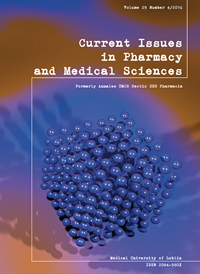Tribological characteristics of dental metal biomaterials
DOI:
https://doi.org/10.1515/cipms-2016-0033Keywords:
wear, dental materials, ball-on-disc test, friction coefficientAbstract
The paper is a report of the examination of the tribological wear characteristics of certain dental metal biomaterials. In the study, tests were undertaken on the following materials: 316L steel, NiCrMo alloy, technically pure titanium (ASTM-grade 2) and Ti6Al4V ELI alloy (ASTM-grade 5). The tribological tests were performed in artificial saliva to determine the coefficient of friction and wear factor; the traces of wear were then ascertained through SEM. The significance of variations in the wear factor, was subsequently assessed by the U Mann-Whitney test. The resistance to wear in the ball-on-disc test under in vitro conditions was observed for the tested materials in the following order: NiCrMo>316L>Ti6Al4V>Ti grade 2.References
1. Chladek W. (2008). Biomechanika inżynierska narządu żucia. Zagadnienia wybrane. Gliwice: Wyd. Pol. Śl.; p. 169.
2. Faria A.C.L. et al.: Wear resistance of experimental titanium alloys for dental applications. J. Mech. Behav. Biomed. Mater., 4, 1873, 2011.
3. Iijima D. et al.: Wear properties of Ti and Ti-6Al-7Nb castings for dental prostheses. Biomaterials, 24, 1519, 2003.
4. Jałbrzykowski M. et al.: Aspects of exploitation stability of selected dental prosthetic bridges. Acta Mech. Autom., 5, 54, 2011.
5. Li-Juan X. et al.: Microstructure and dry wear properties of Ti-Nb alloys for dental prostheses. Trans. Nonferrous Met. Soc. China, 19, 639, 2009.
6. Lin H.-Y. et al.: Metallurgical, surface, and corrosion analysis of Ni-Cr dental casting alloys before and after porcelain firing. Dent. Mater., 24, 378, 2008.
7. Long M., Rack H.J.: Friction and surface behavior of selected titanium alloys during reciprocating-sliding motion. Wear, 249, 158, 2001.
8. Milewski G. (2002). Wytrzymałościowe aspekty interakcji biomechanicznej tkanka twarda – implant w stomatologii. Kraków: Zeszyty Naukowe Politechniki Krakowskiej, seria Mechanika; p. 89.
9. Nine M.J. et al.: Wear Debris Characterization and Corresponding Biological Response: Artificial Hip and Knee Joints. Materials, 7, 980 2014.
10. PN-EN ISO 10271: 2012. Stomatologia – Metody badania korozji materiałów metalowych.
11. Rocha L.A., Oliveira F., Cruz H.V., Sukotjo C., Mathew M.T. (2013). Bio-tribocorrosion in dental applications. Chapter in a book: Yan Y. (editor) Bio-Tribocorrosion in Biomaterials and Medical Implants. Cambridge: Woodhead Publishing Limited; pp. 223-249
12. Souza J.C.M. et al.: Simultaneous degradation by corrosion and wear of titanium in artificial saliva containing fluorides. Wear, 292-293, 82, 2012.
13. Strietzel R.: Ponowne odlewanie stopów dentystycznych. Dent. Labor.,4, 3, 2000.
14. Vieira A.C. et al.: Influence of pH and corrosion inhibitors on the tribocorrosion of titanium in artificial saliva. Wear, 261, 994, 2006.
15. Walczak M. (2014). Influence of the selected technological processes on durability of metal-ceramic systems used in dental prosthetics. Lublin: Published by Lublin University of Technology; p. 183.
16. Walczak M., Pieniak D., Niewczas A.M.: Effect of recasting on the useful properties CoCrMoW alloy. Eksploatacja i Niezawodność – Maintenance and Reliability, 16, 330, 2014.
17. Walczak M., Różycki Ł.: Analiza naprężeń w twardych tkankach zębów na przykładzie dolnego siekacza z wykorzystaniem metody MES. Postępy Nauki i Techniki, 11, 107, 2011.
18. Wang L. et al.: Friction and wear behaviors of dental ceramics against natural tooth enamel. J. Eur. Ceram., 32, 2599, 2012.
19. Wataha J.C. et al.: Brushing-induced surface roughness of nickel-, palladium-, and gold-based dental casting alloys. J. Prosthet. Dent.,99, 455, 2008.
20. Żmudzki J. (2012). Uwarunkowania materiałowe wydolności czynnościowej całkowitych osiadających protez zębowych [Online]. Open Access Library: http://www.openaccesslibrary.com/vol10/4.pdf [2016, May 12].
Downloads
Published
Issue
Section
License
Copyright (c) 2017 Authors

This work is licensed under a Creative Commons Attribution-NonCommercial-NoDerivatives 3.0 Unported License.


